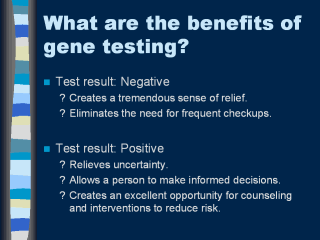|
|
|
|
front |1 |2 |3 |4 |5 |6 |7 |8 |9 |10 |11 |12 |13 |14 |15 |16 |17 |18 |19 |20 |21 |22 |23 |24 |25 |26 |27 |28 |29 |30 |31 |32 |33 |34 |35 |36 |37 |38 |39 |40 |Glossary |review |
 |
Persons in high-risk families live with troubling uncertainties about their own
future as well as that of their children. A negative test - especially one that
is strongly predictive - can create a tremendous sense of relief. A negative test, especially one that is strongly predictive, also may eliminate the need for frequent checkups and tests such as annual colonoscopy (a procedure that allows a physician to view the upper reaches of the large intestine), which are routine for high-risk families concerned about cancer. A positive test can also produce benefits. It can relieve uncertainty, and it can allow a person to make informed decisions about his or her future. Under the best of circumstances, a positive test creates an excellent opportunity for counseling and interventions to reduce risk. The prime example is colon cancer. When tumors are caught early, chances for survival are greatest, and screening potentially could prevent thousands of cancer deaths a year. A positive gene test sounds the alert to keep up regular screening practices (annual colonoscopies to check for precancerous polyps or the earliest signs of cancer) and to maintain healthful lifestyle measures such as a high-fiber, low-fat diet and regular exercise. Another option is surgery to remove the colon before cancer has a chance to develop. |